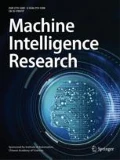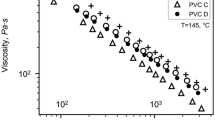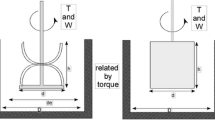Abstract
This work proposes a soft sensor based on a phenomenological model for online estimation of the density and viscosity of a slurry flowing through a pipe-and-fittings assembly (PFA). The model is developed considering the conservation principle applied to mass and momentum transfer and considering frictional energy losses to include the variables directly affecting slurry properties. A reported proposal for state observers with unknown inputs is used to develop the first block of the observer structure. The second block is constructed with two options for evaluating slurry viscosity, generating two possible estimator structures, which are tested using real data. A comparison between them indicates different uses and capabilities according to available process information.
Similar content being viewed by others
References
M. C. Bourne. Texture, viscosity, and food. Food Texture and Viscosity: Concept and Measurement, 2nd ed., M. C. Bourne, Ed., London, UK: Academic Press, pp. 1–32, 2002. DOI: 10.1016/B978-012119062-0/50001-2.
R. J. Oglesby, H. J. Moynihan, R. B. Santos, A. Ghosh, P. W. Hart. Does kraft hardwood and softwood pulp viscosity correlate to paper properties? Tappi Journal, vol. 15, no. 10, pp. 643–651, 2016.
S. Taborda, D. A. Muñoz, H. Alvarez. Snowball effect detection and control proposal for its correction. In Proceedings of IEEE Conference on Control Applications, IEEE, Buenos Aires, Argentina, pp. 1173–1178, 2016. DOI: 10.1109/CCA.2016.7587965.
W. Whiten, P. Steffens, J. Hitchins. An examination of pulp viscosity in tubes at higher shear rates. Minerals Engineering, vol. 6, no. 4, pp. 397–404, 1993. DOI: 10.1016/0892-6875(93)90018-I.
F. N. Shi, T. J. Napier-Munn. Effects of slurry rheology on industrial grinding performance. International Journal of Mineral Processing, vol. 65, no. 3–4, pp. 125–140, 2002. DOI: 10.1016/S0301-7516(01)00060-6.
M. C. Bourne. Viscosity measurement. Food Texture and Viscosity, 2nd ed., M. C. Bourne, Ed., London, UK: Academic Press, pp. 235–256, 2002. DOI: 10.1016/B978-012119062-0/50006-1.
Y. Fangary, A. S. A. Ghani, S. M. El Haggar, R. A. Williams. The effect of fine particles on slurry transport processes. Minerals Engineering, vol. 10, no. 4, pp. 427–439, 1997. DOI: 10.1016/S0892-6875(97)00019-8.
M. Z. He, Y. M. Wang, E. Forssberg. Slurry rheology in wet ultrafine grinding of industrial minerals: A review. Powder Technology, vol. 147, no. 1–3, pp. 94–112, 2004. DOI: 10.1016/j.powtec.2004.09.032.
M. J. Tippett, J. Bao. Distributed control of chemical process networks. International Journal of Automation and Computing, vol. 12, no. 4, pp. 368–381, 2015. DOI: 10. 1007/s11633-015-0895-9.
R. P. Chhabra, J. F. Richardson. Rheometry for non-Newtonian fluids. Non-Newtonian Flow and Applied Rheology: Engineering Applications, 2nd ed., R. P. Chhabra, J. F. Richardson, Eds., Oxford, UK: Butterworth-Heinemann, pp. 56–109, 2008. DOI: 10.1016/B978-0-7506-8532-0.00002-0.
D. Hodouin. Methods for automatic control, observation, and optimization in mineral processing plants. Journal of Process Control, vol. 21, no. 2, pp. 211–225, 2011. DOI: 10.1016/j.jprocont.2010.10.016.
D. Sbárbaro, R. Del Villar. Advanced Control and Supervision of Mineral Processing Plants, London, UK: Springer, 2010. DOI: 10.1007/978-1-84996-106-6.
K. M. Hangos, I. T. Cameron. Process Modelling and Model Analysis, San Diego, USA: Academic Press, 2001.
E. Hoyos, D. López, H. Alvarez. A phenomenologically based material flow model for friction stir welding. Materials & Design, vol. 111, pp. 321–330, 2016. DOI: 10.1016/j. matdes.2016.09.009.
R. B. Bird. Transport Phenomena, Sterling Heights, USA: Wiley, 2007.
R. Darby. Chemical Engineering Fluid Mechanics, 2nd ed., New York, USA: Marcel Dekker, 2001.
I. Govender, G. B. Tupper, A. N. Mainza. Towards a mechanistic model for slurry transport in tumbling mills. Minerals Engineering, vol. 24, no. 3–4, pp. 230–235, 2011. DOI: 10.1016/j.mineng.2010.08.010.
D. Muñoz, J. L. Diaz, S. Taborda, H. Alvarez. Hydrocyclone phenomenological-based model and feasible operation region. International Journal of Mining, Materials, and Mechanical Engineering, vol. 3, pp. 1–9, 2017.
K. J. Astrom, B. Wittenmark, Computer-controlled Systems: Theory and Design, 3rd ed., Berlin, Germany: Prentice Hall, 1997.
M. Darouach, M. Zasadzinski, S. J. Xu. Full-order observers for linear systems with unknown inputs. IEEE Transactions on Automatic Control, vol. 39, no. 3, pp. 606–609, 1994. DOI: 10.1109/9.280770.
M. Roco, C. A. Shook. Modeling of slurry flow: The effect of particle size. The Canadian Journal of Chemical Engineering, vol. 61, no. 4, pp. 494–503, 1983. DOI: 10.1002/cjce. 5450610402.
C. F. Ihle, A. Tamburrino. Uncertainties in key transport variables in homogeneous slurry flows in pipelines. Minerals Engineering, vol. 32, pp. 54–59, 2012. DOI: 10.1016/j. mineng.2012.03.002.
H. Alvarez, R. Lamanna, P. Vega, S. Revollar. Methodology for obtaining phenomenological based semiphysical models applied to a sugar cane juice tower. Iberoamericana Journal of Automation and Industrial Information, vol. 6, no. 3, pp. 117–122, 2009.
D. Castañeda, J. Lorena. The Use of Phenomenological Based Semi-physical Models as Virtual Sensors for Density and Viscosity of Mineral Slurries, Master dissertation, Facultad de Minas, Universidad Nacional de Colombia, Colombia, 2017.
W. B. Hooper. The two-K method predicts head losses in pipe fittings. Chemical Engineering, vol. 88, pp. 96–100, 1981.
B. J. Schorle, S. W. Churchill, M. Shacham. Comments on: “An explicit equation for friction factor in pipe”. Industry & Engineering Chemistry Fundamentals, vol. 19, no. 2, pp. 228, 1980. DOI: 10.1021/i160074a019.
G. Besancon. Nonlinear Observers and Applications, Berlin, Heidelberg Germany: Springer, 2007. DOI: 10.1007/978-3-540-73503-8.
J. Garcia-Tirado, H. Botero, F. Angulo. A new approach to state estimation for uncertain linear systems in a moving horizon estimation setting. International Journal of Automation and Computing, vol. 13, no. 6, pp. 653–664, 2016. DOI: 10.1007/s11633-016-1015-1.
K. Hfaïedh, K. Dahech, T. Damak. A sliding mode observer for uncertain nonlinear systems based on multiple models approach. International Journal of Automation and Computing, vol. 14, no. 2, pp. 202–212, 2017. DOI: 10. 1007/s11633-016-0970-x.
G. F. Aguilera. Mineral slurry viscosity simulation using neural networks, Master dissertation, Facultad de Minas, Universidad Nacional de Colombia, Colombia, 2005. [Online], Available: https://doi.org/intranet.minas.medellin.unal.edu.co/index.php?option=com_docman&taskdoc_download&gid986&Itemid285
K. Madlener, B. Frey, H. K. Ciezki. Generalized Reynolds number for non-Newtonian fluids. Progress in Propulsion Physics, vol. 1, pp. 237–250, 2009. DOI: 10.1051/eucass/200901237.
D. A. Muñoz, C. J. L. Diaz, H. Alvarez. Unknown input observer to estimate slurry rheological properties. In Proceedings of the 3rd Colombian Conference on Automatic Control, IEEE, Cartagena, Colombia, 2017. DOI: 10.1109/CCAC.2017.8276418.
J. L. Diaz C, C. Ocampo-Martinez, H. Alvarez. Nonlinear moving horizon estimator for online estimation of the density and viscosity of a mineral slurry. Industrial & Engineering Chemistry Research, vol. 56, no. 49, pp. 14592–14603, 2017. DOI: 10.1021/acs.iecr.7b04393.
Acknowledgments
The authors thank Colciencias and SUMICOL (Suministros de Colombia S.A.) for their support and financing for this project.
Author information
Authors and Affiliations
Corresponding author
Additional information
Recommended by Associate Editor Jyh-Horng Chou
Jenny L. Diaz C. received the B. Sc. degree in chemical engineering and the M. Sc. degree in engineering with an emphasis on chemical engineering from Universidad Nacional de Colombia, Colombia in 2014 and 2016, respectively. Currently, she is a Ph. D. degree candidate in automatic at Universitat Politcnica de Catalunya, Spain.
Her research interests include modeling of chemical processes, estimation and control theory and large-scale systems management.
Diego A. Muñoz received the B. Sc. degree in chemical engineer from Universidad Nacional de Colombia, Colombia in 2004, the M. Sc. degree in mathematics from Universidad Nacional de Colombia, Colombia in 2006, and the Ph. D. degree in engineering from RWTH Aachen University of Technology, Germany in 2015. Currently he holds a full professor position at Engineering School, Universidad Pontificia Bolivariana, Venezuela, performing both research activities and teaching in the undergraduate and graduate programs.
His research interests include process optimization, modelling and control.
Hernan Alvarez received the B. Sc. degree in chemical engineer from Universidad Nacional de Colombia, Colombia in 1991, the M. Sc. degree in Systems Engineering from the Universidad Nacional de Colombia, Colombia in 1995, and the Ph. D. degree in control systems engineering from Instituto de Automática of Universidad Nacional de San Juan, Argentina in 2000. Currently, he holds a full professor position at Faculty of Mines, Processes and Energy School, Universidad Nacional de Colombia, performing both research activities and teaching in the undergraduate and graduate programs.
His research interests include chemical process modelling and control.
Rights and permissions
About this article
Cite this article
Diaz C., J.L., Muñoz, D.A. & Alvarez, H. Phenomenological Based Soft Sensor for Online Estimation of Slurry Rheological Properties. Int. J. Autom. Comput. 16, 696–706 (2019). https://doi.org/10.1007/s11633-018-1132-0
Received:
Accepted:
Published:
Issue Date:
DOI: https://doi.org/10.1007/s11633-018-1132-0




